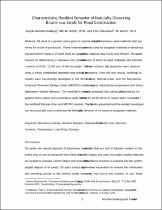 ResearchSpace
ResearchSpace
Characterizing resilient behavior of naturally occurring bituminous sands for road construction
JavaScript is disabled for your browser. Some features of this site may not work without it.
- ResearchSpace
- →
- Research Publications/Outputs
- →
- Journal Articles
- →
- View Item
| dc.contributor.author |
Anochie-Boateng, Joseph

|
|
| dc.contributor.author |
Tutumluer, E

|
|
| dc.date.accessioned | 2012-01-16T10:41:01Z | |
| dc.date.available | 2012-01-16T10:41:01Z | |
| dc.date.issued | 2010-11 | |
| dc.identifier.citation | Anochie-Boateng, J and Tutumluer, E. 2010. Characterizing resilient behavior of naturally occurring bituminous sands for road construction. Journal of Materials in Civil Engineering, Vol. 22(11), pp 1085-1092 | en_US |
| dc.identifier.issn | 0899-1561 | |
| dc.identifier.uri | http://ascelibrary.org/mto/resource/1/jmcee7/v22/i11/p1085_s1?isAuthorized=no | |
| dc.identifier.uri | http://hdl.handle.net/10204/5486 | |
| dc.description | Copyright: 2010 American Society of Civil Engineers. This is a pre print version of the work. The definite version is published in Journal of Materials in Civil Engineering, Vol. 22(11), pp 1085-1092 | en_US |
| dc.description.abstract | Oil sand is a generic name given to natural deposits of bituminous sand materials that are mined for crude oil production. These materials are currently used as subgrade materials of temporary and permanent roads in oil sand fields for operating large capacity haul trucks and shovels. This paper focuses on determining in laboratory the resilient behavior of three oil sand materials with bitumen contents of 8.5, 13.3, and 14.5% by weight. The resilient modulus MR properties were obtained using a newly established repeated load triaxial test procedure. From the test results, nonlinear MR models were successfully developed in the forms of K-theta, Witczak-Uzan, and the mechanistic empirical pavement design guide MEPDG models to properly characterize temperature and stress dependent resilient behavior. The modified K-theta model predicted the overall MR dependency on applied stress states and temperature quite satisfactorily for all the three oil sands when compared to the modified Witczak-Uzan and MEPDG models. The MR results presented and the models developed can be practically used to estimate the field stiffness behavior of oil sands as subgrade materials. | en_US |
| dc.language.iso | en | en_US |
| dc.publisher | American Society of Civil Engineers | en_US |
| dc.relation.ispartofseries | Workflow request;5763 | |
| dc.subject | Bituminous sands | en_US |
| dc.subject | Resilient modulus | en_US |
| dc.subject | Repeated loads | en_US |
| dc.subject | Triaxial tests | en_US |
| dc.subject | Bitumen contents | en_US |
| dc.subject | Load pulse duration | en_US |
| dc.subject | Road construction | en_US |
| dc.subject | Civil Engineering | en_US |
| dc.title | Characterizing resilient behavior of naturally occurring bituminous sands for road construction | en_US |
| dc.type | Article | en_US |
| dc.identifier.apacitation | Anochie-Boateng, J., & Tutumluer, E. (2010). Characterizing resilient behavior of naturally occurring bituminous sands for road construction. http://hdl.handle.net/10204/5486 | en_ZA |
| dc.identifier.chicagocitation | Anochie-Boateng, Joseph, and E Tutumluer "Characterizing resilient behavior of naturally occurring bituminous sands for road construction." (2010) http://hdl.handle.net/10204/5486 | en_ZA |
| dc.identifier.vancouvercitation | Anochie-Boateng J, Tutumluer E. Characterizing resilient behavior of naturally occurring bituminous sands for road construction. 2010; http://hdl.handle.net/10204/5486. | en_ZA |
| dc.identifier.ris | TY - Article AU - Anochie-Boateng, Joseph AU - Tutumluer, E AB - Oil sand is a generic name given to natural deposits of bituminous sand materials that are mined for crude oil production. These materials are currently used as subgrade materials of temporary and permanent roads in oil sand fields for operating large capacity haul trucks and shovels. This paper focuses on determining in laboratory the resilient behavior of three oil sand materials with bitumen contents of 8.5, 13.3, and 14.5% by weight. The resilient modulus MR properties were obtained using a newly established repeated load triaxial test procedure. From the test results, nonlinear MR models were successfully developed in the forms of K-theta, Witczak-Uzan, and the mechanistic empirical pavement design guide MEPDG models to properly characterize temperature and stress dependent resilient behavior. The modified K-theta model predicted the overall MR dependency on applied stress states and temperature quite satisfactorily for all the three oil sands when compared to the modified Witczak-Uzan and MEPDG models. The MR results presented and the models developed can be practically used to estimate the field stiffness behavior of oil sands as subgrade materials. DA - 2010-11 DB - ResearchSpace DP - CSIR KW - Bituminous sands KW - Resilient modulus KW - Repeated loads KW - Triaxial tests KW - Bitumen contents KW - Load pulse duration KW - Road construction KW - Civil Engineering LK - https://researchspace.csir.co.za PY - 2010 SM - 0899-1561 T1 - Characterizing resilient behavior of naturally occurring bituminous sands for road construction TI - Characterizing resilient behavior of naturally occurring bituminous sands for road construction UR - http://hdl.handle.net/10204/5486 ER - | en_ZA |





